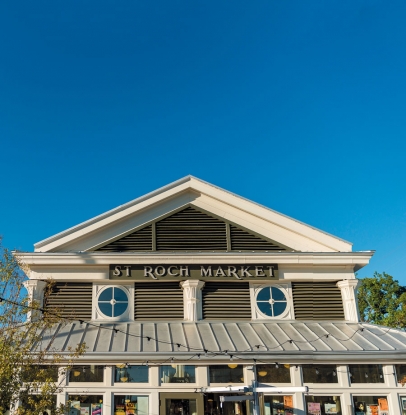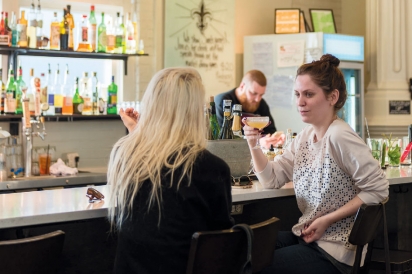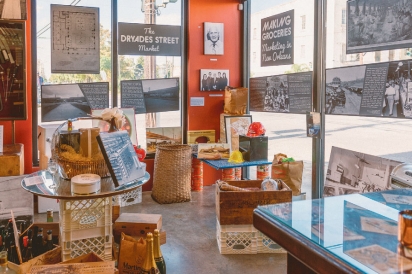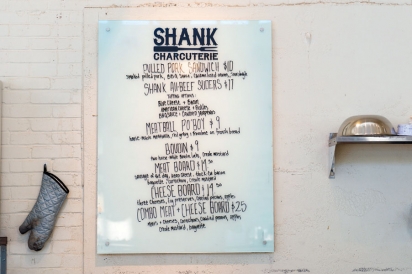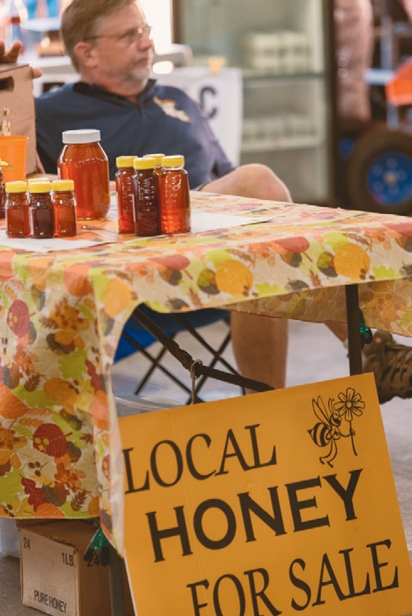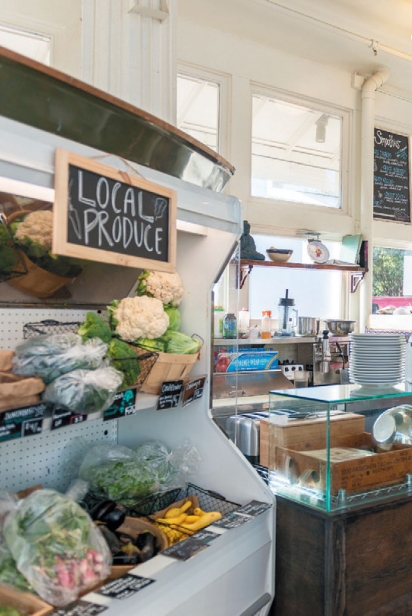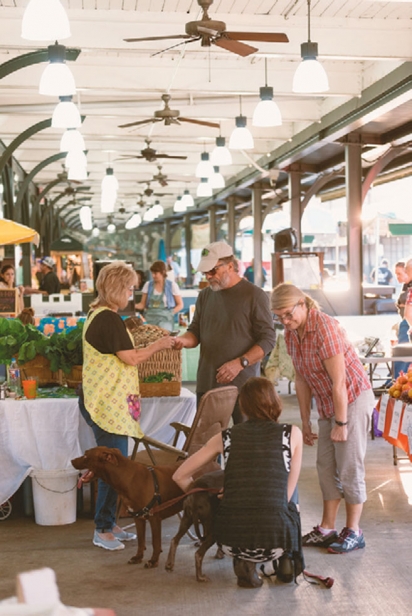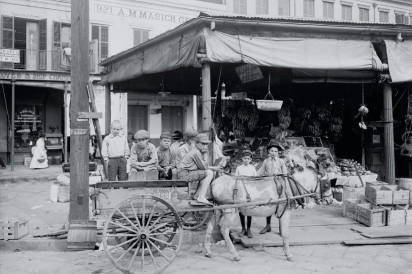The History & Revitalization of New Orleans’ Public Food Markets
The French Market is one of New Orleans’ most emblematic landmarks. Images and descriptions of this public food market pepper the pages of travel guides, novels and other writings about the city. By consequence, it appears monolithic and unique. What most people do not know is that the French Market once sat at the heart of a network of 34 public food markets in New Orleans—one of the largest municipal market systems in the country.
Many of these market buildings still stand today. City administrators and developers have stripped the buildings of their original purpose as food spaces and have converted them into residential condominiums, boutique shops and offices, but their imprint remains.
Although obscured by the passage of time, New Orleans’ public markets brought the people, ingredients and cultures of the world together in a vibrant food scene. Amidst the stalls stocked with ingredients from around the Gulf region, city residents exchanged ideas about ingredients and cooking techniques that now serve as the building blocks of Creole cuisine.
HISTORICAL BACKGROUND
The Spanish colonial government of New Orleans established the central market in its current location in 1791. Prior to the building’s construction, most food vendors sold goods from itinerant stalls along the levee or in city’s streets, without protection from the elements. The new market building provided a sheltered space for vendors to congregate and sell their wares. And by bringing the vendors together under one roof, city officials could more easily regulate the quality and pricing of food.
As New Orleans’ population grew, improvements were made to accommodate the growing number of people who depended on the market for provisions. In 1808, the city government approved the construction of a new market building. French-born architects Arsène Lacarrière Latour and Barthélémy Lafon designed a 300-foot-long and 49-foot-wide building with brick columns and a 12-foot overhang. When a devastating hurricane destroyed the building in 1812, a new structure was built the following year, with a stucco-covered brick exterior, slate roof and Doric columns. This market, although altered, still stands today and houses Café du Monde, one of the city’s most iconic eateries. But in the early 19th century it was known by the French term Halle des Boucheries (“Meat Market”) because it housed the city’s meat vendors. Today, a plaque marks the building’s historic importance as the oldest market structure in the city. Bolted into the stucco, it reads: “Halle des Boucheries. Built—1813. Restored–1975.”
The Halle des Boucheries was the first of many buildings that eventually made up the French Market complex. In 1822, the city government again expanded the French Market to include a separate building for the vegetable market. As New Orleans’ economy and population boomed in the first half of the 19th century, more buildings were constructed for the sale of fish, fruit and dry goods.
IMPRESSIONS
Throughout the French Market’s history, residents and visitors alike commented on its impressive scale. While on a tour of the American South in 1830, for example, Anne Newport Royall, a travel writer and journalist, recorded her impressions: “I had a real feast, viewing the market, which exceeds all the markets put together I have seen in the tour.”
Royall was particularly struck by the sheer volume of products and people moving through the “astonishingly crowded” market, writing, “Besides several rows of benches, the floor and the outside of the market are strewed so thick with vegetables and bowls of beans, as to render it difficult to walk through them.” The market’s commercial space spilled out from the overhang and into the streets, often impeding the flow of traffic along the levee.
In the first half of the 19th century, many of the vendors jockeying for position in this bustling overflow were enslaved and free women of color. They called out to customers, entreating them to purchase steaming bowls of gumbo; creamy pralines; and piping hot calas, sugary rice fritters with culinary origins in West Africa. One of the more famous cries was that of the calas vendors who sang out in French, “Calas, belles calas, tout chaud!” (“Rice fritters, beautiful rice fritters, very hot!”)
Many vendors not fortunate enough to occupy the coveted stalls within the market set up itinerant stands on its fringes. Some of these vendors operated portable restaurants and sought out customers among the throng of people “making groceries.” Royall described the laborious routine of a woman vendor en route to the market to set up one such restaurant:
She will take a small, light table, say large enough for four persons; she then turns this table upside down, and placing her coffee-pot, steak, (bread, butter, and cream she gets at the market-house,) plates, knives, and forks, cups and saucers, within the frame of the table, a friend aids her in placing it on her head, and away she [goes] to the market, with her table cloth on her arm; when she reaches the market house she unships her cargo, turns the table over upon its legs, and sets the breakfast on. When she has served her customers, she turns the table again, places the things on as before, and returns to her dwelling.
While this vendor prepared her food off site, some vendors set up roadside kitchens to provide to-order street foods, similar to the food trucks of today.
CREOLE FUSION FOOD
A major port city, New Orleans attracted European immigrants throughout the 19th and well into the 20th century. Upon their arrival, many newcomers found work as food vendors. French, German, Irish and Italian immigrants, among others, worked alongside the Caribbean and African women who had long been key figures in the local food economy. These immigrant vendors from throughout the Atlantic world brought traditions from their homelands, introducing new ingredients and cooking techniques to their customers in the Crescent City. At the same time, these vendors adopted and adapted the cooking traditions of New Orleans in their own kitchens. The market and its surrounding streets became critical spaces in which New Orleans’ food culture took shape, giving birth to Creole fusion cuisine.
FURTHER EXPANSIONS
Between 1810 and 1820, New Orleans’ population doubled, reaching 27,000 people. In order to accommodate this influx, the city government not only expanded the French Market but also built the first market outside of the French Quarter. This smaller neighborhood market, dubbed St. Mary’s Market, catered to the growing population located upriver of the French Quarter. If the original St. Mary’s market still stood today, it would have been catty-corner to Chef Donald Link’s restaurant Cochon in the Central Business District.
Between 1830 and 1840, New Orleans’ population doubled again, making New Orleans the third-largest city in the country after New York and Baltimore. The city government responded to new demands for food markets by expanding the St. Mary’s Market and constructing several new markets in rapidly growing neighborhoods throughout the city.
The markets were typically shed-like structures ranging from 20 to 30 feet wide and between 80 and 120 feet long (roughly the size of a tennis court) with a roof supported by wood or iron columns that encouraged airflow while also providing shade and shelter from inclement weather. Their open-air design enabled vendors to pull carts and wagons under the overhang for easy loading and unloading.
The city government continued to build neighborhood markets through the first decade of the 20th century. In total, the city constructed 34 public markets—an unprecedented number in the United States. Most American cities only operated one or two larger, enclosed markets.
These markets did not typically cater to specific neighborhoods, instead attracting diverse customers from throughout a city. By contrast, New Orleans’ neighborhood markets were much more intimate commercial and community spaces. Vendors in these markets catered to the taste preferences of specific community members, and each market offered a unique set of fresh and prepared foods that reflected the culinary traditions of the people in the surrounding neighborhood.
The markets’ importance, however, stretched far beyond their roles as central retail spaces. These neighborhood markets hosted important public amenities such as post office drop boxes and telephones. Several of the public markets also had cupolas that housed fire bells.
The markets also served as community meeting grounds for concerts, dances and festivals—even political rallies in the fall of 1865. According to the Daily Picayune, the Democratic Party “showed his teeth and claws most fiercely” at a Dryades Market rally in Central City. In response, the Conservative Party held a meeting at the market a few day later, turning a seemingly benign civic space into a political showground.
New Orleans’ markets continued to be important community spaces through the mid-20th century. As a result, people continued to write about them in travel narratives, novels and memoirs. One hundred years after Royall visited the city, Hermann Keyserling noted in America Set Free that a “walk through the market halls of New Orleans is probably the most remarkable sight of culture-born beauty one can find in the United States,” likening the arrangement of produce to bunches of flowers.
In the early-20th century, many of the markets underwent renovations. The municipal government enclosed the open-air structures and fitted them with electricity, plumbing and air ventilation systems to meet the changing demands of vendors and customers.
With the help of the Works Progress Administration (WPA), the city government completely restructured the market system in the 1930s. Under the direction of architect Sam Stone Jr. the renovated buildings became some of the finest examples of public markets in the country. They were designed to be both practical, furnished with the newest refrigeration and ventilation technologies, and stunning, decorated with imported Italian tile floors, wrought-iron detailing and street-side flowerbeds.
After World War II, most markets in the United States faced sharp decline, and the markets in New Orleans were no exception. Cities experienced significant population loss as Americans moved into the suburbs. As a result, vendors in municipal markets and the surrounding streets lost a substantial portion of their customer base.
The post-war period also marked a dramatic shift in American consumer habits. Americans began to favor convenient processed foods over the raw ingredients found in public markets. Further, customers viewed the public markets as antiquated retail spaces, preferring the modern, air-conditioned interiors of grocery stores. As public markets lost customers, they quickly became unprofitable. Unable to compensate for profit losses, the city government of New Orleans relinquished control of its public markets in 1946.
In the years that followed, some of the public markets were converted into privately owned grocery stores. A few of them still operate today, including the Circle Food Store and the Algiers Central Market, which occupy the old St. Bernard Market in the Seventh Ward and Foto Market in Algiers, respectively. Many of New Orleans’ historic market buildings were, however, renovated and repurposed as commercial, educational and residential spaces. The Jefferson Market on Magazine Street, for example, now operates as the gymnasium for St. George’s Episcopal School. The squeak of tennis shoes on varnished floors creates a soundscape very different from the vendor calls that used to echo in the cavernous ceiling of this historic market building.
REVIVAL
Other historic market buildings have recently been reclaimed and preserved as food spaces. Under the supervision of Executive Director John Smith, the French Market has once again become a space to purchase fresh foods from local farmers. Starting in the fall of 2014, the French Market Corporation has partnered with the Crescent City Farmers Market to host a market on Wednesday evenings. Catering to the needs of French Quarter residents, vendors offer local produce from farms such as Tomott’s Cajun Farm in Larose, Louisiana, and Perrilloux Farms in Montz, Louisiana. In December of 2014, the French Market gained another gourmet food stall, Continental Provisions, which features cheeses from the St. James Cheese Co., meats from Cleaver & Co., and breads from Bellegarde Bakery.
The St. Roch Market located on St. Claude Avenue reopened its doors as a fine foods hall in the spring of 2015. The company’s website pays homage to the market’s historic importance, stating that it was “a mainstay of the turn-of-the-century creole neighborhood carrying the same name.” Today, patrons of the St. Roch Market can purchase locally inspired foods from 13 different vendors including Elysian Seafood, Shank Charcuterie and Koreole. For some neighboring residents, the restored market is a symbol of New Orleans’ post-Katrina revival. Others, however, see St. Roch as a harbinger of gentrification and are calling for a more affordable, inclusive grocery store in the neighborhood.
In addition to their resurrection as retail food spaces, some of the markets have been converted into cultural spaces. The Dryades Market, established in 1849, is the new home of the Southern Food and Beverage Museum (SoFAB). The main hall of the old market now houses the Leah Chase Gallery, an exhibit space dedicated to the foodways of the American South. Through public programming, SoFAB endeavors to reintroduce the New Orleans community to its rich public market history—one that stretched far beyond the Doric columns of the French Market and out along the city’s network of neighborhood markets.
In the last few years, New Orleanians have begun to embrace the long-forgotten history of the city’s expansive public market system. By reviving these historic markets and honoring their role as critical civic spaces, New Orleanians are gaining deep insights into the pivotal role of markets, food vendors and customers in the making of Creole food culture.
The city’s iconic food vendors with their sonorous calls may be a relic of the past, but the buildings in which they created the city’s fusion food are all around us. The next time you indulge in the blue crab beignets at La Petite Grocery or sample the smoky baba ganoush at Shaya, see if you can spot the old Jefferson Market building at the intersection of Magazine and General Pershing streets. The building is clearly marked, “Jefferson Market 1917.” While looking upon its stately facade, it is easy to imagine the steady flow of customers seeking to purchase sweet corn and summer squash on a balmy August morning.
The calas vendors sang out in French,” Calas, belles calas, tout chaud!”
(“Rice fritters, beautiful rice fritters, very hot!”)
Ashley Rose Young is a PhD candidate in history at Duke University. She is also a guest curator & research fellow at the Southern Food & Beverage Museum in New Orleans.


